At the end of the 1930s, the Soviet Union’s Krasnaya Armiya (Red Army) embodied Stalin’s military strength. It had five million troops, more than 300 divisions, a formidable reserve, and included the Voenno-Vozdushnye Sily (VVS), the Air Force. It seemed invincible, and Defense Commissar Kliment Voroshilov even said so to delegates at the 1939 Party Congress.
In August 1939, Stalin and Hitler executed a nonaggression pact essentially giving Stalin a free hand in the Baltic States and Bessarabia, the region around modern-day Moldova encompassing parts of Ukraine and Romania. Stalin wrung concessions from Estonia, Latvia, and Lithuania—a prelude to absorbing them later into the USSR—then set his gaze upon Finland.
Finland, a nation of 3.7 million confronting one more than 40 times larger, seemed doomed—particularly since years of political indifference, questionable acquisition priorities, and complacency had left its military undersized, underfunded, and poorly equipped.
A Drawn-out Slugfest
The Red Army had more than one million soldiers already deployed on its borders; Finland, prior to mobilization, had just 33,000. The VVS and Soviet Navy deployed 2,300 aircraft; the Finns had just 114.
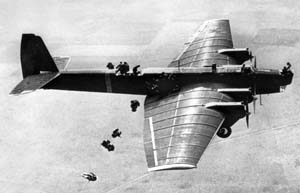
| ||
| Soviet paratroopers tumble out of a Tupolev TB-3. Finland shot down at least one of the transport-bomber aircraft early in the war, along with dozens of other bombers. (Photo courtesy of Air Force Historical Research Agency, via Richard P. Hallion) |
Finnish troops had several months’ worth of ammunition, some czarist-legacy artillery, and few tanks or heavy machine guns. Fortunately, they wielded an excellent Finnish-made submachine gun, giving them withering close-combat firepower.
Finland’s “Mannerheim Line”— named after Field Marshal Carl Gustaf Mannerheim—defending the Karelian Isthmus was simply coils of barbed wire, some obstructions, and occasional machine gun nests connecting lakes and marshes. As its namesake soberly reflected, “The Mannerheim Line is the Finnish soldier standing in the snow.”
Yet the fiercely patriotic Finns refused to give in. “So many Russians! Where will we bury them all?” one soldier quipped. His jest soon proved grimly prophetic.
Stalin launched all-out war on Nov. 30, 1939. The Red Army assaulted the Mannerheim Line, also invading central Finland to sever supply lines from Sweden. The Soviet Navy prowled the coast. Aloft, VVS fighters and bombers struck at ports, cities, and installations.
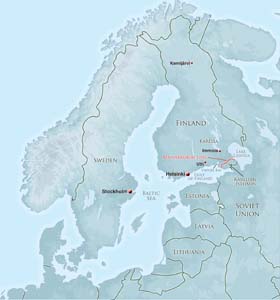
| ||
|
(Staff map by Zaur Eylanbekov) |
But the offensive quickly degenerated into a drawn-out slugfest, with the thrust into central Finland ending in a grim landscape of abandoned vehicles and frozen, snow-covered corpses. Everywhere white-clad Finnish snipers took a deadly toll, as did ski troops, attacking swiftly out of the woods with submachine guns, grenades, and tank-destroying Molotov cocktails. Stalin’s Navy suffered from coastal artillery, its landing attempts repulsed.
But nowhere did the Finns fight more tenaciously than in the air.
Finland established an air service in 1918, when a group of adventurers joined its fight against the Bolsheviks. One of them, Sweden’s Eric von Rosen, donated an airplane marked with his personal good luck symbol, a blue swastika. It became the official Finnish air emblem (but had no connection to the Nazis’ later use of the symbol).
In 1928, the air service became the Ilmavoimat, the Air Force. But it was inadequately supported by the Army and Navy traditionalists who dominated the general staff and who selected Army- and maritime-centric leaders to run it. On the positive side, Finnish airmen became masters of making do, operating under rough conditions, even in the frozen tundra and wastes of the high Arctic. They developed portable shelters and heating for exposed aircraft; mobile logistical support to enable austere operations; and thorough unit-level maintenance.
In 1936 Finland purchased two squadrons of British Bristol Blenheim bombers and two more Dutch Fokker D.XXI fighters. But it needed more fighters. The Finnish Air Chief was Jarl F. Lundqvist, an artillery officer turned air commander. His predilection for bombers and maritime patrol constrained Finnish fighter modernization at a time when world fighter design was evolving rapidly.
Frustrated fighter advocates saw numerous opportunities missed to secure better, more advanced, aircraft that, in retrospect, could have dramatically affected the Winter War.
Thus, in 1940, the obsolete Fokkers constituted the front line of Finnish air defense, even though they only had an armament of four 7.9 mm machine guns and a maximum speed of just 286 mph. Still, they were fast enough to intercept most bombers and were potentially deadly opponents if flown by skilled pilots.
Finland’s fighter pilots were superbly trained, thanks to Lt. Col. Richard Julius Lorentz and Capt. Gustaf Erik Magnusson. In the early 1930s, Lorentz commanded Lentolaivue 24 (LeLv 24), Finland’s premier fighter squadron. It was a time when his pilots took pride in flying a tight three-ship Royal Air Force-inspired V-shaped arrowhead. But Lorentz realized it limited effectiveness and increased vulnerability.
Setting the Stage for Defense
Instead, he made an element of two fighters, leader and wingman, the basic formation. He stressed mutual protection, gunnery, use of radio in aircraft and ground observer networks, and exploiting signals intelligence. His initiatives created a crude command and control system, with radar being unavailable to Finland at the time of the Winter War. As well, he encapsulated his thinking in an air war manual issued in 1939.
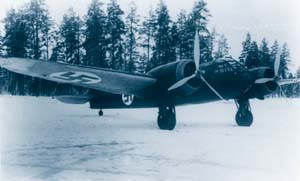
| ||
|
When the war began, Finland had 18 Bristol Blenheim light bombers, such as this one at Immola. Finland marked its military aircraft with blue swastikas, a good luck symbol. There was no connection to Nazi Germany’s ubiquitous use of the ancient symbol. (Photo courtesy of Mikko Veijalainen, Military Aviation Museum of Central Finland, via Richard P. Hallion) |
“Eka” Magnusson, one of Lorentz’s flight commanders, was so interested in tactics that he traveled at his own expense to fly with France’s l’Armée de l’Air. He returned impressed by its use of gun cameras for analysis and by the extensive critique following each training mission.
In 1938, now himself commanding LeLv 24, he visited Germany. Magnusson returned convinced Europe was at best a year away from war. He exercised LeLv 24 hard, emphasizing tactics, marksmanship, and maintenance. He advocated beam and stern attacks, deflection shooting, and firing at short range, targeting gunners first, and then engines and pilots.
Magnusson pitted his Fokkers against each other and against older but more nimble Bristol Bulldog biplanes. It was excellent preparation: The Fokker pilots learned not to attempt turning fights against biplanes such as the Polikarpov I-15bis and I-153.
In the fall of 1939, as Soviet reconnaissance incursions increased, Lorentz (newly appointed as commander of fighters) dispersed his aircraft. Teams prepared caches of supplies and ammunition and loaded trucks with spare parts, tools, and other necessities.
“Our esprit de corps was high despite the fact that we would be up against heavy odds,” ace Ilmari Juutilainen recalled later. “We were ready.”
Russia’s Air Force outnumbered Finland’s by 20 to one. The Soviet Union deployed 2,318 aircraft, including 1,044 fighters and 855 bombers. The Soviets had 395 others for strategic bombing, paratroop insertion, reconnaissance, artillery observation, and maritime patrol. In contrast, Finland’s 114 aircraft included 42 Fokkers, 15 older Bulldogs, and 18 Blenheims.
On Nov. 30, amidst bad weather that shielded Stalin’s airmen from Finnish interception, eight bombers set out to raid port and oil storage facilities near Helsinki. But they missed their targets and instead dropped bombs across the city, killing almost 100 Finns—and triggering international outrage.
The next day, when more returned, they ran into a swarm of Fokkers led by Magnusson. The angry Finns swiftly shot down 11 Soviet bombers, one falling before Magnusson’s own guns.
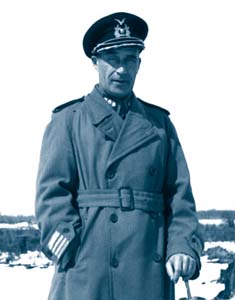
| ||
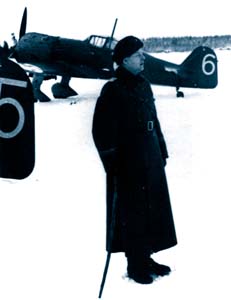 |
||
|
Col. Richard Lorentz (top) and Maj. Gustaf Magnusson (bottom) readied and trained a cadre of superb Finnish pilots who fought tenaciously in the air despite being greatly outnumbered. |
That encounter established a pattern for the subsequent air war. Finnish pilots focused on destroying bombers, engaging fighters only when necessary or when defending their own bomber and reconnaissance aircraft.
On Dec. 19, LeLv 24’s pilots shot down 12 bombers, one pilot recalling, “Everything went exactly like training.” On Dec. 23, they destroyed six bombers and two fighters, at the cost of one Fokker lost—its pilot survived.
LeLv 24 ended the year having shot down 54 aircraft for the price of one Fokker.
On Jan. 6, 17 Ilyushin DB-3 bombers flew across the Gulf of Finland from Estonia, but signals intelligence had alerted the Finns of the impending raid. Thus, near Utti, the second wave of eight encountered a Fokker piloted by 1st Lt. Per-Erik Sovelius, who shot one bomber down.
The remainder were attacked by 1st Lt. Jorma Sarvanto. In just four minutes, Sarvanto shot down six. The seventh Soviet bomber then fell to Sovelius, who caught it as it crossed the coast.
On Jan. 17, the Finns intercepted 25 Tupolev SBs over Karelia, shooting down nine and damaging several others. Three days later, they shot down a further nine, at the cost of one Fokker and pilot lost to a pair of I-16s.
Altogether, in the month of January 1940, Finland’s Fokkers shot down 34 Soviet aircraft, primarily bombers.
A Brutal Cold Winter
Throughout the war, Lorentz and Magnusson repeatedly stressed attacking bombers, reconnaissance, and artillery spotters. Over time, as the threat of Soviet fighters increased, the Finns refined their tactics further, so that once a bomber formation was located, dispersed radio-directed fighters would “swarm” and attack in great numbers, destroying as many as possible before returning to dispersed bases.
The Finns constantly shifted detachments among remote sites with tamped-down snow runways. They operated off frozen lakes using skis instead of wheels. As the winter of 1939-40 was brutally cold, maintenance was a nightmare. Mechanics risked frostbite and even used blowtorches to keep tools warm.
Accidents caused by fatigue—for pilots flew up to eight sorties each day—constituted as much a danger as Soviet fighters and anti-aircraft fire. By the end of January, LeLv 24 had only 28 mission-capable Fokkers left.
Fortunately, diplomatic efforts to secure additional airplanes were now bearing fruit. Arriving aircraft were assembled in Sweden, and a total of 116 aircraft were readied by the end of March.
Britain sent 30 Gloster Gladiator biplanes, the French supplied 30 Morane-Saulnier MS 406 monoplanes, and South Africa donated 29 Gauntlets (the Gladiator’s predecessor).
Finland ordered other fighters, including 35 Italian Fiat G.50 monoplanes (32 of them delivered before war’s end), 44 American Brewster B-239s (an export version of the US Navy’s F2A-1, though only a few had been delivered before hostilities ceased), and a dozen British Hawker Hurricanes, 10 of which arrived, though too late to participate in the campaign.
The Moranes and Fiats, with generally similar performance to the Fokkers, proved equally deadly against the Soviet bombers beginning in February 1940.
Many foreigners volunteered for Finnish military service, but as the Finns were highly selective, few actually flew. The only organized foreign air unit was the Swedish volunteer squadron, Flygflottilj 19 (F19), commanded by Maj. Hugo Beckhammar. Made up of aviators and support personnel from the Flygvapnet (the Swedish Air Force), it consisted of a dozen Gloster Gladiator biplane fighters and four two-seat Hawker Hart biplane dive bombers.
F19 entered combat in early January, completing 464 sorties over 62 days, losing five aircraft in combat and one in an accident. In turn, its pilots destroyed eight (and possibly 12) Soviet aircraft, including a four-engine Tupolev TB-3 shot down outside Kemijärvi on March 10. The F19’s presence freed the Finnish Air Force to concentrate its efforts over the Karelian Isthmus.
In January, Stalin replaced Voroshilov with Semyon K. Timoshenko, a cavalry commander and systematic planner. He instituted an all-forces training program while building up his artillery and armor. Then, in February, he unleashed an assault.
Mannerheim’s doughty troops repelled this latest Soviet assault as well, though at great cost.
Finnish Air Force fighters now turned to ground attack, strafing troops and vehicles trying to cross Lake Ladoga and, later, Viipuri Bay and other iced-over waterways. From the air, each column looked like “a long black snake,” Capt. Eino Luukkanen recalled. “We could not have been offered a better target.” One strike repulsed a battalion-sized column, leaving half its vehicles and personnel dead on the ice.
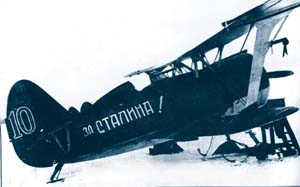
| ||
|
A Polikarpov I-15bis sports a “For Stalin!” slogan on its flank. The biplanes were deadly foes in turning fights, but the Finns knew how to avoid that sort of battle. (Photo courtesy of George Mellinger Collection, via Richard P. Hallion) |
Patrolling Soviet fighters increased the risk to Finnish airmen as well. “We grimly went in at extremely low level and emptied our guns,” Chief Warrant Officer Eino Ilmari Juutilainen recalled, “then it was save yourself against the enemy fighters who would roar down from overhead. … Those ground attacks were the most miserable missions we flew during the Winter War.”
Timoshenko’s strategy and resources eventually succeeded. Massed artillery fire, followed by armor and infantry assaults breached the Mannerheim Line on Feb. 12. Still, Finnish discipline held, and its soldiers withdrew in good order to a secondary defense line. Though France and Britain offered assurances of imminent aid, the Finns realized both countries were more concerned about their own war with Germany.
The Finns also knew other European states were reluctant to risk widening the war, one that might even see Germany entering on the side of its erstwhile ally, the Soviet Union.
An Uneasy Peace
In early March, Sweden announced it would not permit any foreign forces to cross its territory to fight in Finland. Messages from Mannerheim and other front commanders grew increasingly pessimistic.
On March 6, after much debate, a Finnish delegation left for Stockholm, then flew on to Moscow, arriving the next day. There, on March 12, Finnish and Russian conferees signed a treaty of peace. The next day, at 11 a.m. Helsinki time, an uneasy peace returned, beginning, as Finnish journalist and diplomat Max Jakobson recalled, a “day of quiet, bitter mourning.”
The Winter War cost Finland 68,480 casualties, including 24,923 dead or missing, and 43,557 wounded. Its casualties constituted nearly two percent of the nation’s population. Finland lost 10 percent of its territory and the Karelian Isthmus, whose remaining inhabitants took refuge in Finland rather than remain in place as Soviet subjects.
Still, Finland’s ferocious defense saved it from having to form a puppet state and sharing the fate of Lithuania, Latvia, and Estonia. The Soviet empire eventually absorbed each of those once-independent nations. More than a million Baltic citizens vanished into the labor camps of the gulag, where most were shot or worked to death.
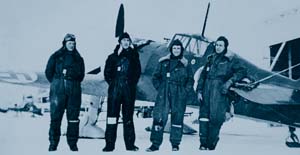
| ||
|
LeLv 24 pilots—four shown here with a Fokker D.XXI—claimed 120 air-to-air victories. Though obsolete, the Fokker racked up a 16-to-one kill ratio. (Photo courtesy of Mikko Veijalainen, Military Aviation Museum at Central Finland, via Richard P. Hallion) |
For Stalin, any satisfaction derived from conquering Finland was tempered by the Red Army’s amateurish performance and extreme casualties. Soviet fatalities numbered 273,000—10 times more than Finland’s—with thousands more wounded. The combined casualty total was likely a quarter of the 1.2 million Soviet soldiers deployed.
Asked what had been gained, one Soviet general replied, “We have won enough ground to bury our dead.”
Stalin characteristically reacted in Draconian fashion, wasting little time in assigning blame and punishments.
He considered the 5,648 Soviet soldiers and airmen taken prisoner by the Finns to be traitors. When they returned, they immediately passed from the humane captivity of the Finns into gulags. Few, if any, survived.
In March, Voroshilov was forced, in Stalin’s words, to “acknowledge the bankruptcy of his leadership.” Yakov Shmushkevich, chief of the VVS was arrested and shot, together with other airmen and ground commanders.
But Stalin himself bore the greatest responsibility for the Red Army’s miserable performance. His purges had claimed the cream of its officer corps and almost all its senior leadership, resulting in the elevation of inexperienced and ill-trained subordinates. Coupled with organizational and training weaknesses, this meant the Red Army was a hollow force, vulnerable to a better trained and focused opponent.
This particularly held true for the VVS. While its airmen had fought over Spain, China, and Manchuria, they had little experience in combined arms warfare or following established doctrine and tactics. Many of the most experienced had been purged as well, robbing the VVS of the benefits of their knowledge.
Though the Winter War gave the Red Army and the VVS an inkling of vital changes each had to make, both still possessed serious deficiencies when, slightly over a year later, Germany invaded the USSR.
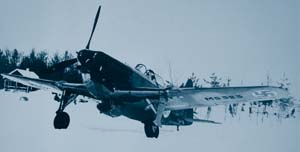
| ||
|
France supplied Finland with 30 Morane-Saulnier MS 406 aircraft, such as this one, to help the war effort against the Soviets, but France was clearly more concerned with its own war, against Nazi Germany. (Photo courtesy of Mikko Veijalainen, Military Aviation Musuem of Central Finland, via Richard P. Hallion) |
Finland’s Air Force ended the Winter War stronger than it had been at its outbreak. It was now combat-proven, seasoned, and confident. Finnish airmen had acquitted themselves with obvious distinction, and that March, an American air attaché reported, “The accomplishments thus far of the Finnish pilots have been truly remarkable.”
The Finns claimed 521 Soviet aircraft in the course of 5,963 sorties: 207 shot down air-to-air and another 314 falling to ground fire. Of these, Lorentz’ fighters claimed 170, more than 80 percent of Soviet aircraft allegedly lost in air-to-air action. Of the 170, Magnusson’s LeLv 24 claimed 120, a hundred of them (83 percent) bombers. Finnish fighter pilots frustrated the VVS’ efforts to undertake systematic bombing operations, undoubtedly saving hundreds, and perhaps thousands, of lives—particularly civilians in various towns and cities who otherwise would have perished.
Standards of Performance
Though obsolescent, the Fokker D.XXI achieved a 16-to-one kill ratio, due to the courage, training, tactics, and marksmanship of its pilots. Ten Finnish pilots earned ace status, accounting for 68 bombers and fighters. Finland lost 62 aircraft, mostly bombers, reconnaissance, and artillery spotters.
The single worst engagment, from Finland’s perspective, occurred Feb. 29. Due to intelligence failures, 40 Polikarpov fighters surprised and trapped a mix of Fokkers and Gladiators over Immola. In the multibogie furball that followed, VVS pilots shot down seven Finnish aircraft, while losing four of their own.
But this marginal victory constituted the apex of Soviet success. Stalin may have lost 900 aircraft, almost eight times the number Finland possessed at the war’s outset.
In June 1941, Hitler abrogated the pact with the USSR, sending his Wehrmacht into Soviet-occupied Poland and across the Soviet frontier. Finland joined Germany as a co-belligerent, hoping to regain its lost territory. The “Continuation War” lasted through the summer of 1944, during which Finnish airmen again dominated the VVS.
Despite the vast power of the Red Army, which forced a settlement, the Finns again succeeded in retaining their independence, avoiding the postwar fate of Eastern Europe, though again they lost much territory. The Paris Peace Treaty of 1947 constrained the size of Finland’s Air Force in the postwar era, though not its excellence.
Today the Finnish Air Force operates F-18 Hornets and BAE Hawks with advanced precision munitions. Its airmen exercise with the Nordic air forces, and those of other nations, including the United States.
If Finland’s equipment has vastly changed, its standard of performance has not. Today as then, the Finnish Air Force punches well above its weight.
Richard P. Hallion is an aerospace historian who served 11 years as the Air Force historian and has written widely on aerospace technology and airpower topics. His previous article for Air Force Magazine, “Richard Whitcomb’s Triple Play,” appeared in the February 2010 issue.